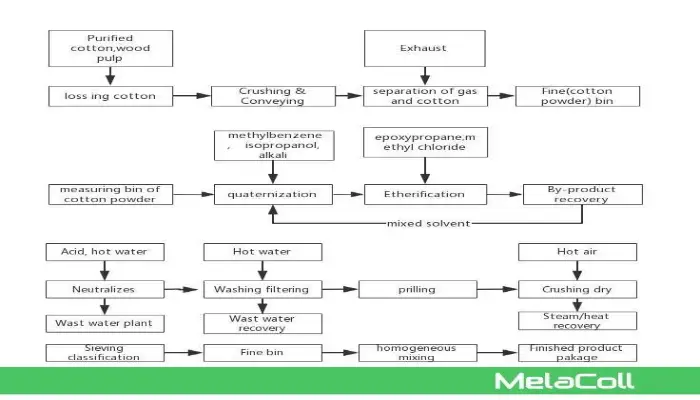
1. O que é o método de produção em fase líquida?
O método de produção em fase líquida (método de produção de pasta) para a produção de HPMC requer um sistema misto de acetona, isopropanol, terc-butanol, tolueno, 1,2-metoxietano ou hidrocarbonetos de baixa qualidade e um pequeno número de álcoois de baixa qualidade como solvente (ou dispersante) para fazer com que a celulose seja totalmente misturada com o alcalino, cloreto de metila, óxido de propileno e similares em um sistema de pasta como o estado de pasta líquida para concluir a reação de alcalinização e eterificação da celulose. Esse método de produção exige que as matérias-primas de madeira e celulose de algodão sejam trituradas com antecedência.
O processo de operação específico do método de produção em fase líquida do MelaColl™ HPMC baseia-se nos requisitos de desempenho e índice do produto. O produtor pode adotar o método de alcalinização → eterificação ou adotar o método sequencial de alcalinização → eterificação → alcalinização secundária → eterificação secundária em vários estágios para obter o produto acabado com melhor uniformidade e maior grau de substituição.
O específico Processo de produção de HPMC: O produtor pode dispor o pó fino de celulose triturada em um reator vertical ou horizontal com um dispositivo de agitação forte, disperso em um solvente e, em seguida, adicionar uma certa quantidade de líquido alcalino, óxido de propileno e cloreto de metila para eterificação e reação. Após a conclusão da reação, o produto acabado é obtido por meio de lavagem com água quente, secagem, trituração e peneiramento.
O fluxograma do método de produção é mostrado na figura a seguir:
O principal equipamento para o método de produção em fase líquida:
| Item | Cota de consumo | Item | Cota de consumo | ||
| Matérias-primas | Celulose/T | 0.84-0.88 | Matéria-prima | Um solvente misto de tolueno e isopropanol/t | 0.07-0.10 |
| 50% Líquido alcalino/T | 0.86-1.00 | Potência | Água/t | 50.00-60.00 | |
| Cloreto de metila/T | 0.57-0.70 | Eletricidade/kWh | 3000-3500 | ||
| Óxido de propileno/T | 0.19-0.21 | Vapor/t | 8.00-9.00 | ||
O método de produção adota os solventes mais mistos de tolueno e isopropanol como dispersantes. A principal pressão de reação usada no método de produção é inferior a 1MPa. Após a conclusão da reação, o solvente misto de tolueno e o isopropanol é recuperado.
A tecnologia de produção permite a produção de cloreto de polivinila (PVC), produtos de HPMC de grau de construção, grau farmacêutico e grau alimentício.
2. As vantagens e as deficiências do método de produção em fase líquida
O método de produção em fase líquida tem as seguintes vantagens: A pressão interna do equipamento de reação é pequena, a exigência de pressão do equipamento é baixa e o perigo é mínimo. Depois que a celulose é impregnada na solução alcalina, a celulose é totalmente expandida, e a celulose alcalina e o líquido alcalino podem ser alcalinizados uniformemente para obter melhor infiltração e inchaço da celulose. O reator de eterificação é pequeno, e a celulose alcalina é uniformemente inchada, o que permite que o produtor controle facilmente a qualidade do produto para obter uma melhor uniformidade em termos de grau de substituição e viscosidade. Além disso, o produtor pode alterar facilmente a variedade desejada do produto.
Mas o método de produção em fase líquida também tem as seguintes deficiências: O reator geralmente não é muito grande (abaixo de 15 m3), e a capacidade é pequena devido a restrições estatísticas. É necessário adicionar mais de um reator para aumentar a produção. O refino e a purificação de produtos brutos exigem muitos equipamentos, operações complexas e alta intensidade de mão de obra. Como não é realizado nenhum tratamento à prova de molde ou de composição, a estabilidade da viscosidade do produto e os custos de produção são afetados. Quando um produtor adota esse método de embalagem manual, sua intensidade de mão de obra e seus custos se tornam mais caros.
O grau de automação do controle da reação no método de produção em fase líquida é menor do que no método de produção em fase gasosa, portanto, a precisão do controle é menor. Diferentemente do método de produção em fase gasosa, o método de produção em fase líquida requer um sistema complexo de recuperação de solventes. Atualmente, algumas novas tecnologias de produção estão sendo continuamente desenvolvidas, e a fórmula do hidroxipropilmetil também está sendo continuamente aprimorada para atender às necessidades especiais de produtos em vários campos. Além disso, além do hpmc, novos éteres mistos estão sendo constantemente desenvolvidos.


Deixe uma resposta